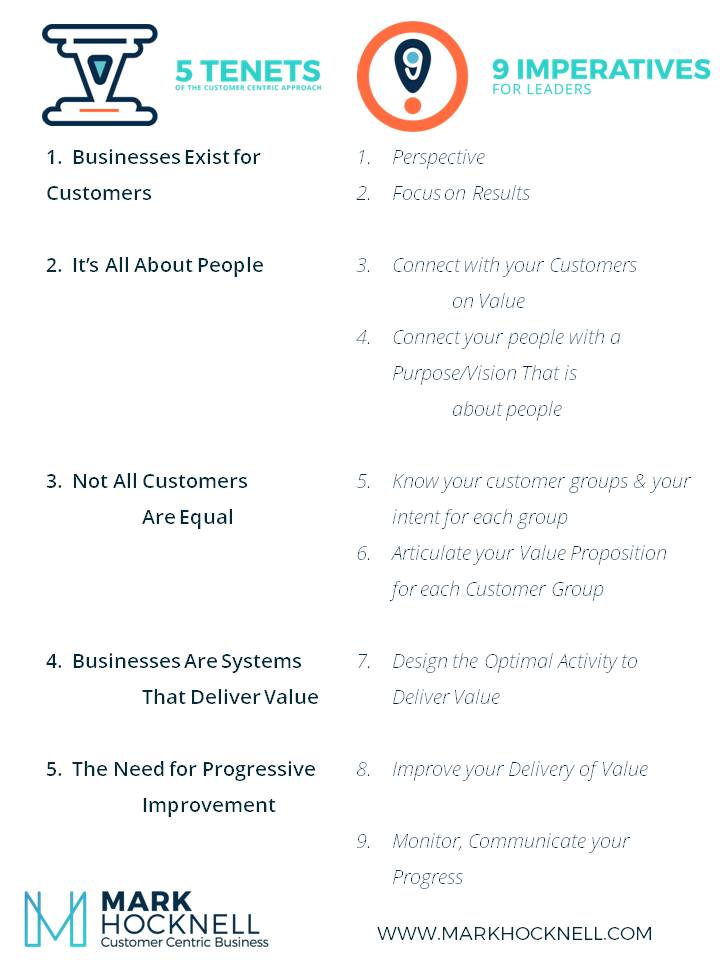Customer centricity bring enormous benefits to organisations. Apply the customer centric business approach, use the five key tenets and the nine imperatives for leaders to drive greater levels of success for all types of organisations.
This success is then seen in increased profitability and engagement with customers and employees.
Customer Centricity is not a ‘bolt-on’
Customer centric is not something we can bolt on to a business. To become a customer centric business and reap the proven benefits of customer centricity we need to change our approach.
Organisations need to recognise using the Five Tenets of the Customer Centric approach to Business, and applying the Nine Imperatives for leaders.
When commerce was emerging in human history, there was an old path that entrepreneurs used to build networks and relationships. However, today as most leaders and managers take their wisdom from the last century. The old path seems like a new one. This new path leads to deeper levels of engagement with customers and employees, provides higher levels of performance for the business. This new path is the customer centric approach to business.
Customer centricity is not a business bolt-on. We can’t bolt customer experience improvement projects and NPS targets onto old business models and expect dramatic results. Iteration is not innovation. It is time to get on the new path.
The customer centric approach to business has Five Tenets or principles behind it. These Five Tenets demand Nine new Imperatives from Leaders.
The Five Tenets to the Customer Centric Approach to Business.
1. Businesses Exist for Customers – this is true customer centricity
Businesses cannot exist for themselves, however they attempt it. Recognising we exist for customers keeps our perspective grounded, it keeps the people in the business grounded on their core purpose – to deliver value for the customer. When we deliver value for the customer (better than alternatives), the customer responds, with repurchases and advocacy. Wells Fargo forgot this First Tenet, yes they have paid some hefty fines, yes some people have resigned or been sacked. But worse still, they have lost the trust of 100’s of millions of people. Likewise in Australia, the whole failure with the Masters chain was focused on beating a competitor, rather than delivering value for customers, costing billions of dollars.
2. It’s all about People
People bring businesses to life. Customers are people and that provide the revenue and profit for the business. Profit comes from the decisions customers make, not the product or service offered. And it is the other people – employees – that interact with these customers and design services for these customers. Businesses thrive when people around them flourish.
3. Not all Customers are Equal
Not all customers are right for the value you offer. Your awesome customer is the one that gets the value you offer. And they will reciprocate with increased spend and advocacy. The sum profitability for the business is made up of the profitability of the customer portfolio (customer lifetime value is often used to establish part of this value).
In every customer portfolio there is a smaller percentage of customers contributing to the higher proportion of value for the business. The challenge for the business is to find the sweet spot of Two-way Value Exchange.
4. Businesses are Systems that Deliver Value
The business is a collective. The collective output is the delivery of value for the customer (good, bad or indifferent). Business results come from this delivery of this value. The optimal approach from last century was to create silos, for clearer accountability, and then make collaboration a value…
As a leader do you manage a system or a collection of parts that compete and conflict..? You customers know the answer.
All your systems must come together to deliver an outcome. Customer centricity realises organisational goals, through engaging with your customers on purpose.
5. The Need for Progressive Improvement
Your status quo is an evil abode. Many organisations have a culture where inaccurate good news is preferred over accurate bad news. Knowing how you are performing is one of the keys to improvement. Your customer’s expectations are changing. There are people out there vying for your customer’s attention. There are people out there disrupting your traditional market place. Your team is motivated by making progress. Make change the thing that does not change.
Using the Five Tenets to the Customer Centric Approach to Business, these Nine Imperatives for Leaders come into focus.
The Nine Imperatives for Leaders
1.Perspective
Perspective is about the attitude of the leaders. As we know, the culture of the organisation is derived from the perspective of leaders. In short this is about arrogance versus humility. An arrogant attitude or culture in the leadership group destroys businesses. Reflect on the leaders of the Woolworths/Masters mess whose focus was on beating Bunnings, rather than delivering value for customers. Humble leaders serve their customers, serve their employees and use their skills ensure the delivery of value.
2. Focus on Results
A focus on the result or outcome we are trying to achieve will lead to a prioritised set of actions and learning to how achieve the result. Good leaders set the direction, then empower and coach their teams to learn, strive and improve. Distributing targets and KPIs that are not set collaboratively only leads gaming the system and getting a number, not an outcome.
3. Connect with your Customer on Value
Most businesses focus on what they do, then tell anyone who will listen what they do. Our customers today seek value, they seek experiences. People connect with brands and ideas emotionally and intuitively. Create a connection with your customers on value and on a purpose. Give them the reason why. Today, that is true differentiation.
4. Connect your people with a Purpose/Vision that is about people
The people that are your employees want to connect with the people that are your customers – not your financial outcomes. Employees want to know their work is meaningful, for other people, your customers. Our vision, mission and/or purpose cannot be about us. It must be about others, the customers and difference we can make in their world.
5. Know your Customer Groups and you Intent with each group
Most businesses go about their daily activity with a financial budget and set of targets to guide them. Then we wonder why our customer portfolio has customers within it that don’t get our value, they can’t reciprocate the value they don’t get, and then wonder why do they become ‘detractors’ on social media. The activity that attracts and keeps our customers, needs to be guided and coordinated to ensure the system delivers the value we have promised to our customers.
Not all customers are equal. Create a customer strategy.
6. Articulate your Value proposition for each Customer Group
To truly resonate with customers Value propositions need to be two levels. One: about why your customers should engage with you, your business. Two: about what your products and services do for them. Value propositions are then addressed to specific customer groups. If we only tell people what we do, we do not allow them to connect with us emotionally.
7. Design the Optimal Activity to Deliver Value
Let’s know what we need to be doing – let’s figure out the optimal activity that delivers value for our customers. That’s what we implement, not with a ‘set and forget’ mindset but with one that is about learning.
Some of the key elements of this Imperative are covered in the Architecture for Customer Engagement, described in this blog post.
8. Improve your Delivery of Value
Now we need to improve it. We need to monitor how we are performing (performance measures help here), understand and interpret performance (learning) and initiate action. Repeat and repeat.
9. Monitor and Communicate your Progress
Once we have committed to a set of results we will monitor our progress towards the results and communicate to our teams the progress, the learning’s we have gained.
People thrive on the feeling of progress.
Customer centricity – Summary

The Five Tenets of the Customer Centric approach to Business, and the Nine Imperatives for Leaders
For any business to achieve its ultimate goal and purpose – to be meaningful and relevant long-term to its customers, employees and owners – the Nine Imperatives for Leaders need to be their literal and moral compass.
Customer centricity is not a business bolt-on. The Five Tenets recognise that business is human centred.
(The video below explains the process and model for customer centricity – and the background to how we got to where we are.)
The Nine Imperatives for Leaders creates alignment of the resources of the whole organisation for maximum results, for all stakeholders. (You can access the self assessment tool here)
Want to have a conversation about how your organisation can become more customer centric..? Make contact and we can schedule a free 30 minute call.
For more on successful customer centric approaches – I encourage you to sign up for my newsletter (below), and you will receive the Definitive Guide to the Customer Centric approach to Business..!
Additionally consider this about customer centricity:
Forrester is one of the most influential research and advisory firms in the world (their claim on their website).
Forrester are also trying to raise awareness about this shift that is required for businesses in the Age of the Customer. They say:
“This is not a passing storm after which we will return to a comfortable normal.”
“This new world requires leaders to think and act differently.”
Here is a link to their webpage on the Age of the Customer.



